跨文化交际第二章课件
- 格式:pps
- 大小:989.50 KB
- 文档页数:21

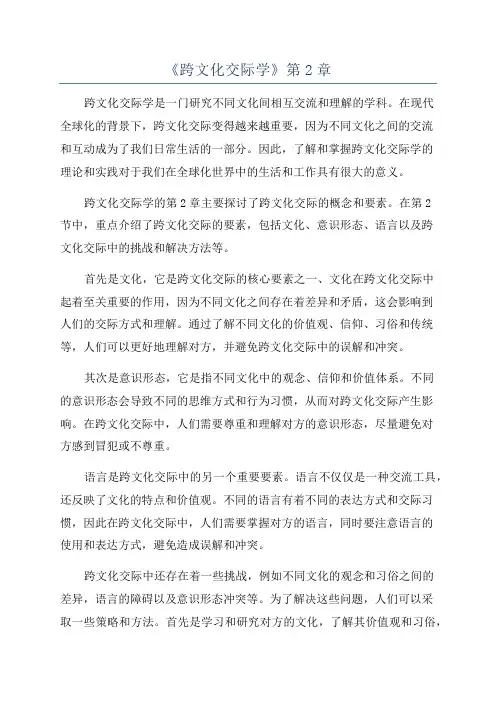
《跨文化交际学》第2章跨文化交际学是一门研究不同文化间相互交流和理解的学科。
在现代全球化的背景下,跨文化交际变得越来越重要,因为不同文化之间的交流和互动成为了我们日常生活的一部分。
因此,了解和掌握跨文化交际学的理论和实践对于我们在全球化世界中的生活和工作具有很大的意义。
跨文化交际学的第2章主要探讨了跨文化交际的概念和要素。
在第2节中,重点介绍了跨文化交际的要素,包括文化、意识形态、语言以及跨文化交际中的挑战和解决方法等。
首先是文化,它是跨文化交际的核心要素之一、文化在跨文化交际中起着至关重要的作用,因为不同文化之间存在着差异和矛盾,这会影响到人们的交际方式和理解。
通过了解不同文化的价值观、信仰、习俗和传统等,人们可以更好地理解对方,并避免跨文化交际中的误解和冲突。
其次是意识形态,它是指不同文化中的观念、信仰和价值体系。
不同的意识形态会导致不同的思维方式和行为习惯,从而对跨文化交际产生影响。
在跨文化交际中,人们需要尊重和理解对方的意识形态,尽量避免对方感到冒犯或不尊重。
语言是跨文化交际中的另一个重要要素。
语言不仅仅是一种交流工具,还反映了文化的特点和价值观。
不同的语言有着不同的表达方式和交际习惯,因此在跨文化交际中,人们需要掌握对方的语言,同时要注意语言的使用和表达方式,避免造成误解和冲突。
跨文化交际中还存在着一些挑战,例如不同文化的观念和习俗之间的差异,语言的障碍以及意识形态冲突等。
为了解决这些问题,人们可以采取一些策略和方法。
首先是学习和研究对方的文化,了解其价值观和习俗,从而更好地进行跨文化交际。
其次是培养跨文化交际能力,包括开放的心态、尊重和理解对方、灵活适应不同的文化环境等。
此外,人们还可以通过建立良好的人际关系和沟通渠道来解决跨文化交际中的问题。
总之,跨文化交际学的第2章第2节主要介绍了跨文化交际的要素和挑战。
通过了解和掌握这些要素,人们可以更好地进行跨文化交际,促进不同文化之间的理解和和谐。


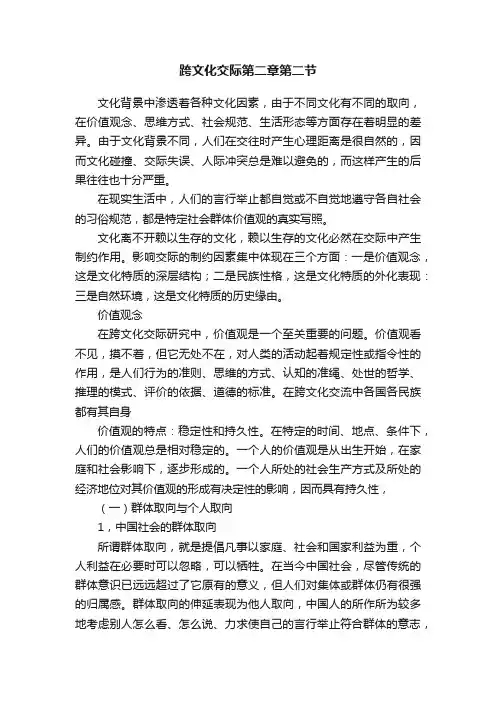
跨文化交际第二章第二节文化背景中渗透着各种文化因素,由于不同文化有不同的取向,在价值观念、思维方式、社会规范、生活形态等方面存在着明显的差异。
由于文化背景不同,人们在交往时产生心理距离是很自然的,因而文化碰撞、交际失误、人际冲突总是难以避免的,而这样产生的后果往往也十分严重。
在现实生活中,人们的言行举止都自觉或不自觉地遵守各自社会的习俗规范,都是特定社会群体价值观的真实写照。
文化离不开赖以生存的文化,赖以生存的文化必然在交际中产生制约作用。
影响交际的制约因素集中体现在三个方面:一是价值观念,这是文化特质的深层结构;二是民族性格,这是文化特质的外化表现:三是自然环境,这是文化特质的历史缘由。
价值观念在跨文化交际研究中,价值观是一个至关重要的问题。
价值观看不见,摸不着,但它无处不在,对人类的活动起着规定性或指令性的作用,是人们行为的准则、思维的方式、认知的准绳、处世的哲学、推理的模式、评价的依据、道德的标准。
在跨文化交流中各国各民族都有其自身价值观的特点:稳定性和持久性。
在特定的时间、地点、条件下,人们的价值观总是相对稳定的。
一个人的价值观是从出生开始,在家庭和社会影响下,逐步形成的。
一个人所处的社会生产方式及所处的经济地位对其价值观的形成有决定性的影响,因而具有持久性,(一)群体取向与个人取向1,中国社会的群体取向所谓群体取向,就是提倡凡事以家庭、社会和国家利益为重,个人利益在必要时可以忽略,可以牺牲。
在当今中国社会,尽管传统的群体意识已远远超过了它原有的意义,但人们对集体或群体仍有很强的归属感。
群体取向的伸延表现为他人取向,中国人的所作所为较多地考虑别人怎么看、怎么说、力求使自己的言行举止符合群体的意志,群体取向的影响有积极的一面也有消极的一面,从积极的方面看,中国人谦虚谨慎,相互依靠,共同合作,提倡集体主义,强调爱国主义,为了集体和国家利益,不惜牺牲个人的利益乃至生命,成功之时,把功劳归于集体力量和他人帮助。
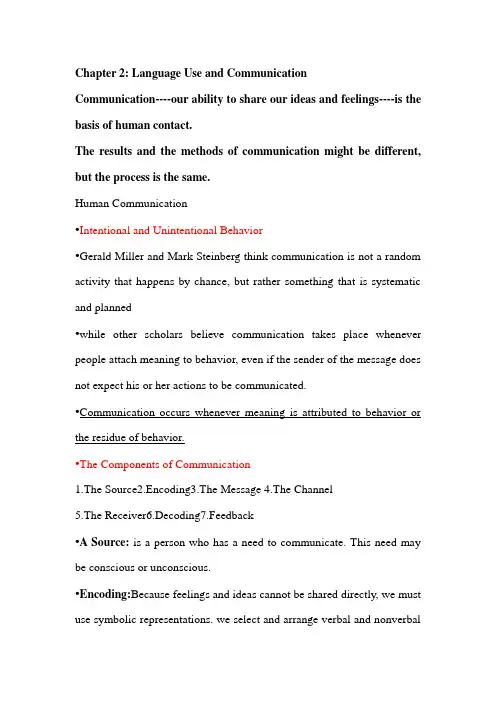
Chapter 2: Language Use and CommunicationCommunication----our ability to share our ideas and feelings----is the basis of human contact.The results and the methods of communication might be different, but the process is the same.Human Communication•Intentional and Unintentional Behavior•Gerald Miller and Mark Steinberg think communication is not a random activity that happens by chance, but rather something that is systematic and planned•while other scholars believe communication takes place whenever people attach meaning to behavior, even if the sender of the message does not expect his or her actions to be communicated. •Communication occurs whenever meaning is attributed to behavior or the residue of behavior.•The Components of Communication1.The Source2.Encoding3.The Message4.The Channel5.The Receiver6.Decoding7.Feedback•A Source: is a person who has a need to communicate. This need may be conscious or unconscious.•Encoding:Because feelings and ideas cannot be shared directly, we must use symbolic representations. we select and arrange verbal and nonverbalsymbols according to our rules of grammar and syntax.•The Massage: encoding produces a message ,which is a set of verbal and nonverbal symbols that a source’s state of being at a par ticular moment. The message is external to the source, while encoding goes on inside the source.•The Channel: the means by which the message move from one person to another is the channel,and the primary channels are sound and sight.•The Receiver: is a person or persons who take the message into account .•Decoding: The receiver decodes the raw energy he or she takes in from the external world and converts it into meaningful experiences. It is information processing. Decoding permits the receiver to attach meaning to the source’s behavior.•Feedback: This is information generated by the receiver and made available to a source that allows the source to make qualitative judgments about the communication while it is taking place.Pragmatics:Language Use•The ProblemLinguistic communication is easily accomplished but not so easily explained.Problems with the message model•1. Disambiguation•2.Under-determination of reference•3.Under-determination of communicative intent•4.Non-literality•5.indirection•6.non-communicative acts•Disambiguation: The message model must be supplemented by principles of contextual appropriateness to compensate for the pervasive ambiguity of natural language.•Example: Flying planes can be dangerous•At an airport zoning, this sentence means the planes flying overhead is dangerous.•At the Pilot’s Insurance Board, this sentence means the risk of piloting planes.•Under-determination of reference:The message model must be supplemented by mechanisms for successfully recognizing the intention to refer to a specific person, place,or thing•Example: the shrewd politician.•Under-determination of communicative intent:•Example:I’ll be there tonight•It might be a prediction, a promise, or even threat, depending upon the speaker’s intentions in the appr opriate circumstances.•Non-literality: we may not mean what our words mean.•Example:Oh that’s just great.•Indirection:A speaker can use the very same sentence to convey quite different messages depending on the context•Example:My car has a flat tire.•It might means requesting a help.•Non-communicative acts: per-locutionary act.Example:•“Raise your hands if you agree!”Dr.William N.Brown begs his Chinese graduate students.•No response.•“Then raise your hands if you disagree!”•Still nothing•“How about raising your hands if you’re awake?”•Some glance about awkwardly, but none dare raise their hands, or break the silent vigil they’re since primary school.•An Inferential adj.可以推论的,据推论得出的Approach to Communication proposes提出four presumptions as the basis of an account of successful linguistic communication.•1.Linguistic Presumption•municative Presumption•3.Presumption of Literalness•4.Conversational Presumptions•Conversational Presumptions:•Relevance : the speaker’s remarks are relevant to the conversation.•Sincerity: the speaker’s is being sincere.Truthfulness: the speaker is attempting to say something true. •Quantity: the speaker contributes the appropriate amount of information.•Quality: the speaker has adequate evidence for what she says.Four characteristics of human language•1.Symbolic•2.rule-govern3.subjective(the meaning of language are reside in people not in words) •4.dynamic•Language is a part of culture ,culture is carry on by language.The Characteristics of Communication 8•No direct mind-to-mind contact•We can only infer•Communication is symbolic•Time-binding links us together•We seek to define the world•Communication has a consequence•Communication is dynamic•Communication is contextual•Communication is self-reflectiveThe Brain is an open system•Each of us can learn new ideas throughout life,what we know at any one instant is a product of what the brain has experienced.•We can learn from each other•Learning is a lifelong endeavor, we can use the information to which we are exposed to change the way we perceive and interact with the world. We are alike and we are different•We are identical in numerous physiological and chemical ways. We all have a heart, lungs,brain,and the like.we are also literally made of the same stuff:water,salt,and so on. We also seek emotional pleasure and flee injury to our feelings. We are also alike because all of us, regardless of our culture,must eventually face four fundamental issues: 1.life is finite 2.we are isolated from all other human beings 3.we need to make choices 4.the world is a meaningful world•We are different, because each of us is unique and is shaped by countless factors. Our experience of the world is internal, therefore, we each respond to the world differently.In a word, a common beginning, gender, age, culture and the like may bind us, but our isolated minds and unique experience keep us apart. Cultural differences also keep us apart. While the four philosophical issues of death, isolation, free choice and meaning confront everyone, the resolutions we decide upon have their roots deep in each culture.。

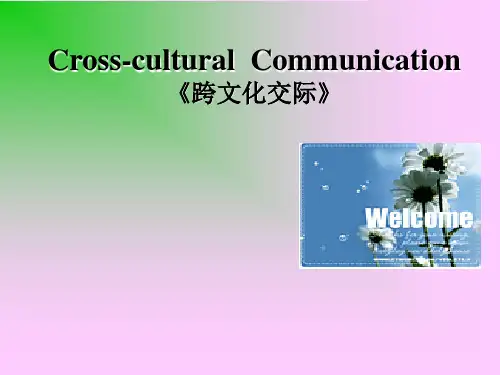

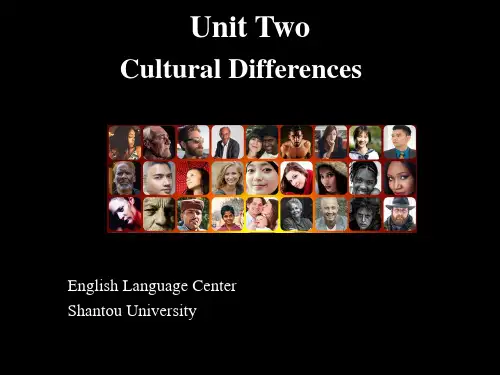
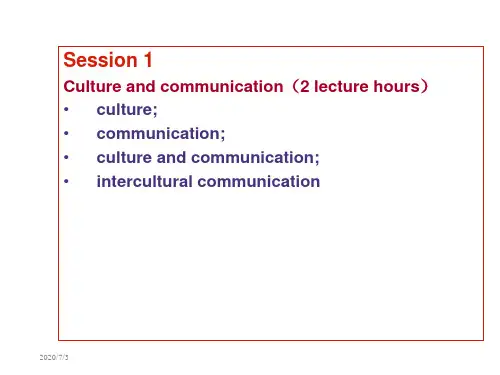
Unit 2 Daily Communication(I)
Case Analysis
Addressing People
Greetings
Initiating Conversations
Conversation Topics
Visiting Someone
Partings
Cases
Twelve cups of tea
Have you had your lunch?
Sitting down
Li Hongzhang’s embarrassment
Borrow Money & Lend Money
Addressing People
Name order: He Xiangu Linda Smith
*Smith *Miss Linda *Teacher He *Teacher
Aunt Mary Uncle Joe Brother Joseph
Sister Anne
Addressing by title, office, profession:
*Principal Morris *Manager Jackson
*Bureau Director Wang Doctor Brown
Mayor White Prof. Lessing Nurse Liu
Captain Fan Colonel Yu
Greetings
Good morning/afternoon/ evening.
How are you?
How are things going?
How are you getting on?
How are things (with you)?
How’s everything?
How’s life?
Hello.
Hey. /Hi.
Chinese expressions
Where are you going?你上哪去?
Where have you been?你去哪里啦?
Have you had your meal?吃过了吗?
(It’s none of your business.)
Concept of privacy
Initiating Conversations
Avoidance of some topics:
Age
Money
Health
Family
Conversation topics
Hobbies
holidays
The weather
A local or national event
Jobs
Films/books
Visiting Someone
Business visiting: arrange a time in advance
some straight to the point
Social visiting: more flexible
*I’m coming to see you this afternoon.
(* means inappropriate)
Can I come and see you this afternoon?
Examples
I haven’t seen you for a long time. I was
wondering whether I could come round to
visit you sometime.
I’d like to come and see you sometime.
Would you be free one afternoon next week?
Mr. Zhang and I would like to come and
visit you. Would it be convenient for us to
come Wednesday evening?
Things to be minded
Advance notice
If you accept a drink, you should drink it
otherwise may offend the Westerner.
Food-offering differences
Partings
Differences:
Westerners:A couple of minutes’ small talk:
Well, it’s been lovely to see you again, but I
must be going soon. I hope we’ll be able to
get together again before long…
Thank you for a lovely evening. I must not
hold you any longer.
Chinese :abrupt leaving-taking
Research Topics
Compare the American friendship with the
Chinese friendship
The Concept of “Privacy” in Western
Culture and “隐私”in Chinese Culture
(Privacy is not equal to 隐私)